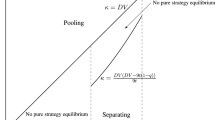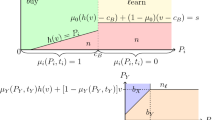Abstract
This paper considers price competition in a duopoly with quality uncertainty. The established firm (the ‘incumbent’) offers a quality that is publicly known; the other firm (the ‘entrant’) offers a new good whose quality is not known by some consumers. The incumbent is fully informed about the entrant’s quality. This leads to price signalling rivalry because the incumbent gains and the entrant loses if observed prices make the uninformed consumers more pessimistic about the entrant’s quality. When the uninformed consumers’ beliefs satisfy the ‘intuitive criterion’ and the ‘unprejudiced belief refinement’, prices signal the entrant’s quality only in a two–sided separating equilibrium and are identical to the full information outcome.
Similar content being viewed by others
Notes
1Linnemer L (2002) shows that in the same setup it would be in some cases more profitable for the high-type firm to combine price and advertising signals.
2 This is equivalent to setting γ≡1.
3 We restrict ourselves to pure strategy equilibria.
5 In our analysis the term ‘unprejudiced belief criterion’ always refers to the simplified version defined above.
6Yehezkel (2006) proposes a generalization of the unprejudiced belief criterion that eliminates all possible separating equilibria but the full information outcome.
7Recall that t>(Δ−c)/3
8 The analysis of (partial) pooling equilibria is likely to be complicated by several necessary case distinctions. First, there are four possible equilibrium constellations since each of the two firms can adopt either full or partial pooling. Second, for the equilibrium prices and all deviations from equilibrium one has to consider not only prices that leave both firms with a positive market share but also prices that would drive one of the firms out of the market.
References
Bagwell K, Ramey G (1991) Oligopoly limit pricing. RAND J Econ 22: 155–172
Bagwell K, Riordan M H (1991) High and declining prices signal product quality. Am Econ Rev 81: 224–239
Barigozzi F, Garella P G, Peitz M (2006) Advertising and prices as signals of quality: competing against a renown brand. Working Paper, University of Bologna
Bester H (1993) Bargaining vs. price competition in markets with quality uncertainty. Am Econ Rev 83: 278–288
Bester H, Ritzberger K (2001) Strategic pricing, signalling, and costly information acquisition. Int J Ind Org 19: 1347–1361
Cho I-K, Kreps D M (1987) Signaling games and stable equilibria. Q J Econ 102: 179–221
Daughety A F, Reinganum J F (2007) Competition and confidentiality: signaling quality in a duopoly when there is universal private information. Game Econ Behav 58: 94–120
Daughety A F, Reinganum J F (2008) Imperfect competition and quality signalling. RAND J Econ 39: 163–183
Fluet C, Garella P G (2002) Advertising and prices as signals of quality in a regime of price rivalry. Int J Ind Org 20: 907–930
Hertzendorf M N, Overgaard P B (2001a) Price competition and advertising signals: signaling by competing senders. J Econ Manag Strateg 10: 621–662
Hertzendorf M N, Overgaard P B (2001b) Prices as signals of quality in duopoly. working paper, school of economics and management, University of Aarhus
Hotelling H (1929) Stability in competition. Econ J 39: 41–57
Janssen M C W, Roy S (2010) Signaling quality through prices in an oligopoly. Game Econ Behav 68: 192–207
Linnemer L (2002) Price and advertising as signals of quality when some consumers are informed. Int J Ind Org 20: 931–947
Milgrom P, Roberts J (1986) Price and advertising signals of product quality. J Political Econ 94: 796–821
Nelson P (1970) Information and consumer behavior. J Political Econ 78: 311–329
Schultz C (1999) Limit pricing when incumbents have conflicting interests. Int J Ind Org 17: 801–825
Shaked A, Sutton J (1982) Relaxing price competition through product differentiation. Rev Econ Stud 49: 3–13
Yehezkel Y (2006) On the robustness of the full-information separating equilibrium in multi–sender signaling games. Tel Aviv University (mimeo)
Yehezkel Y (2008) Signaling quality in an oligopoly when some consumers are informed. J Econ Manag Strateg 17: 937–972
Author information
Authors and Affiliations
Corresponding author
Additional information
We wish to thank three referees for helpful comments and suggestions. Support by the German Science Foundation (DFG) through SFB/TR 15 is gratefully acknowledged.
Rights and permissions
About this article
Cite this article
Bester, H., Demuth, J. Signalling Rivalry and Quality Uncertainty in a Duopoly. J Ind Compet Trade 15, 135–154 (2015). https://doi.org/10.1007/s10842-014-0178-0
Received:
Revised:
Accepted:
Published:
Issue Date:
DOI: https://doi.org/10.1007/s10842-014-0178-0




